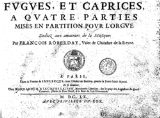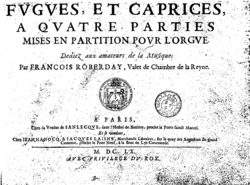
François Roberday
Encyclopedia
François Roberday was a French
Baroque
organist
and composer
. One of the last exponents of the French polyphonic music tradition established by Jean Titelouze
and Louis Couperin
, Roberday is best remembered today for his Fugues et caprices, a collection of four-part contrapuntal
organ
pieces.
in 1624, most probably in March. His family was one of goldsmith
s and musicians: his father, a renowned goldsmith, owned a pipe organ
and François himself was the brother-in-law of Jean-Henri d'Anglebert
, one of the most famous French composers and harpsichord
ist to the King of France. After his father's death, Roberday was appointed King's goldsmith, and in 1659 he bought the job of the official manservant to the Queen. Unfortunately, Roberday's business gradually declined and by the time of his death he was quite poor. He died in 1680 in Auffargis
, a village south of Paris, during an epidemic
.
Roberday was organist of several churches in Paris
, most notably the Notre-Dame des Victoires church and the Petits-Pères church. He was also known as a teacher and Jean-Baptiste Lully
may have been one of his pupils.
 Roberday's most famous work is Fugue
Roberday's most famous work is Fugue
s et caprices, a collection of organ pieces published in 1660 in Paris. The collection includes twelve four-voice fugues, of which numbers 1, 2, 3, 6, 8 and 9 are paired with caprices, fast-paced pieces based on the subjects of their corresponding fugues. These too feature four-part counterpoint
, although slightly less complex than that in the fugues. The fugues use subjects with extensive usage of longer note value
s, which are modified in the caprices to better suit their fast tempi. Many of the pieces feature multiple sections, with a few double fugues and some variation fugues present.
The collection shows considerable Italian
influence and many of the pieces are based on themes from miscellaneous composers of the era, including Girolamo Frescobaldi
, Louis Couperin
, Jean-Henri d'Anglebert
, Johann Jakob Froberger
, Francesco Cavalli
and others. Some researchers (notably Jordi Savall
) regard Fugues et caprices as an important precursor to Johann Sebastian Bach
's The Art of Fugue
. Since the pieces of the collection are non-liturgical
, they make Roberday one of the last composers of the French polyphonic tradition.
France
The French Republic , The French Republic , The French Republic , (commonly known as France , is a unitary semi-presidential republic in Western Europe with several overseas territories and islands located on other continents and in the Indian, Pacific, and Atlantic oceans. Metropolitan France...
Baroque
Baroque
The Baroque is a period and the style that used exaggerated motion and clear, easily interpreted detail to produce drama, tension, exuberance, and grandeur in sculpture, painting, literature, dance, and music...
organist
Organist
An organist is a musician who plays any type of organ. An organist may play solo organ works, play with an ensemble or orchestra, or accompany one or more singers or instrumental soloists...
and composer
Composer
A composer is a person who creates music, either by musical notation or oral tradition, for interpretation and performance, or through direct manipulation of sonic material through electronic media...
. One of the last exponents of the French polyphonic music tradition established by Jean Titelouze
Jean Titelouze
Jean Titelouze was a French composer, poet and organist of the early Baroque period. His style was firmly rooted in the Renaissance vocal tradition, and as such was far removed from the distinctly French style of organ music that developed during the mid-17th century...
and Louis Couperin
Louis Couperin
Louis Couperin was a French Baroque composer and performer. He was born in Chaumes-en-Brie and moved to Paris in 1650–51 with the help of Jacques Champion de Chambonnières. Couperin worked as organist of the Church of St. Gervais in Paris and as musician at the court...
, Roberday is best remembered today for his Fugues et caprices, a collection of four-part contrapuntal
Counterpoint
In music, counterpoint is the relationship between two or more voices that are independent in contour and rhythm and are harmonically interdependent . It has been most commonly identified in classical music, developing strongly during the Renaissance and in much of the common practice period,...
organ
Organ (music)
The organ , is a keyboard instrument of one or more divisions, each played with its own keyboard operated either with the hands or with the feet. The organ is a relatively old musical instrument in the Western musical tradition, dating from the time of Ctesibius of Alexandria who is credited with...
pieces.
Life
He was born in ParisParis
Paris is the capital and largest city in France, situated on the river Seine, in northern France, at the heart of the Île-de-France region...
in 1624, most probably in March. His family was one of goldsmith
Goldsmith
A goldsmith is a metalworker who specializes in working with gold and other precious metals. Since ancient times the techniques of a goldsmith have evolved very little in order to produce items of jewelry of quality standards. In modern times actual goldsmiths are rare...
s and musicians: his father, a renowned goldsmith, owned a pipe organ
Pipe organ
The pipe organ is a musical instrument that produces sound by driving pressurized air through pipes selected via a keyboard. Because each organ pipe produces a single pitch, the pipes are provided in sets called ranks, each of which has a common timbre and volume throughout the keyboard compass...
and François himself was the brother-in-law of Jean-Henri d'Anglebert
Jean-Henri d'Anglebert
Jean-Henri d'Anglebert was a French composer, harpsichordist and organist. He was one of the foremost keyboard composers of his day.-Life:...
, one of the most famous French composers and harpsichord
Harpsichord
A harpsichord is a musical instrument played by means of a keyboard. It produces sound by plucking a string when a key is pressed.In the narrow sense, "harpsichord" designates only the large wing-shaped instruments in which the strings are perpendicular to the keyboard...
ist to the King of France. After his father's death, Roberday was appointed King's goldsmith, and in 1659 he bought the job of the official manservant to the Queen. Unfortunately, Roberday's business gradually declined and by the time of his death he was quite poor. He died in 1680 in Auffargis
Auffargis
Auffargis is a commune in the Yvelines department in north-central France....
, a village south of Paris, during an epidemic
Epidemic
In epidemiology, an epidemic , occurs when new cases of a certain disease, in a given human population, and during a given period, substantially exceed what is expected based on recent experience...
.
Roberday was organist of several churches in Paris
Paris
Paris is the capital and largest city in France, situated on the river Seine, in northern France, at the heart of the Île-de-France region...
, most notably the Notre-Dame des Victoires church and the Petits-Pères church. He was also known as a teacher and Jean-Baptiste Lully
Jean-Baptiste Lully
Jean-Baptiste de Lully was an Italian-born French composer who spent most of his life working in the court of Louis XIV of France. He is considered the chief master of the French Baroque style. Lully disavowed any Italian influence in French music of the period. He became a French subject in...
may have been one of his pupils.
Works

Fugue
In music, a fugue is a compositional technique in two or more voices, built on a subject that is introduced at the beginning in imitation and recurs frequently in the course of the composition....
s et caprices, a collection of organ pieces published in 1660 in Paris. The collection includes twelve four-voice fugues, of which numbers 1, 2, 3, 6, 8 and 9 are paired with caprices, fast-paced pieces based on the subjects of their corresponding fugues. These too feature four-part counterpoint
Counterpoint
In music, counterpoint is the relationship between two or more voices that are independent in contour and rhythm and are harmonically interdependent . It has been most commonly identified in classical music, developing strongly during the Renaissance and in much of the common practice period,...
, although slightly less complex than that in the fugues. The fugues use subjects with extensive usage of longer note value
Note value
In music notation, a note value indicates the relative duration of a note, using the color or shape of the note head, the presence or absence of a stem, and the presence or absence of flags/beams/hooks/tails....
s, which are modified in the caprices to better suit their fast tempi. Many of the pieces feature multiple sections, with a few double fugues and some variation fugues present.
The collection shows considerable Italian
Italy
Italy , officially the Italian Republic languages]] under the European Charter for Regional or Minority Languages. In each of these, Italy's official name is as follows:;;;;;;;;), is a unitary parliamentary republic in South-Central Europe. To the north it borders France, Switzerland, Austria and...
influence and many of the pieces are based on themes from miscellaneous composers of the era, including Girolamo Frescobaldi
Girolamo Frescobaldi
Girolamo Frescobaldi was a musician from Ferrara, one of the most important composers of keyboard music in the late Renaissance and early Baroque periods. A child prodigy, Frescobaldi studied under Luzzasco Luzzaschi in Ferrara, but was influenced by a large number of composers, including Ascanio...
, Louis Couperin
Louis Couperin
Louis Couperin was a French Baroque composer and performer. He was born in Chaumes-en-Brie and moved to Paris in 1650–51 with the help of Jacques Champion de Chambonnières. Couperin worked as organist of the Church of St. Gervais in Paris and as musician at the court...
, Jean-Henri d'Anglebert
Jean-Henri d'Anglebert
Jean-Henri d'Anglebert was a French composer, harpsichordist and organist. He was one of the foremost keyboard composers of his day.-Life:...
, Johann Jakob Froberger
Johann Jakob Froberger
Johann Jakob Froberger was a German Baroque composer, keyboard virtuoso, and organist. He was among the most famous composers of the era and influenced practically every major composer in Europe by developing the genre of keyboard suite and contributing greatly to the exchange of musical...
, Francesco Cavalli
Francesco Cavalli
Francesco Cavalli was an Italian composer of the early Baroque period. His real name was Pietro Francesco Caletti-Bruni, but he is better known by that of Cavalli, the name of his patron Federico Cavalli, a Venetian nobleman.-Life:Cavalli was born at Crema, Lombardy...
and others. Some researchers (notably Jordi Savall
Jordi Savall
Jordi Savall i Bernadet is a Catalan viol player, conductor and composer. He has been one of the major figures in the field of Western early music since the 1970s, largely responsible for bringing the viol back to life on the stage...
) regard Fugues et caprices as an important precursor to Johann Sebastian Bach
Johann Sebastian Bach
Johann Sebastian Bach was a German composer, organist, harpsichordist, violist, and violinist whose sacred and secular works for choir, orchestra, and solo instruments drew together the strands of the Baroque period and brought it to its ultimate maturity...
's The Art of Fugue
The Art of Fugue
The Art of Fugue , BWV 1080, is an incomplete work by Johann Sebastian Bach . It was most likely started at the beginning of the 1740s, if not earlier. The first known surviving version, which contained 12 fugues and 2 canons, was copied by the composer in 1745...
. Since the pieces of the collection are non-liturgical
Liturgy
Liturgy is either the customary public worship done by a specific religious group, according to its particular traditions or a more precise term that distinguishes between those religious groups who believe their ritual requires the "people" to do the "work" of responding to the priest, and those...
, they make Roberday one of the last composers of the French polyphonic tradition.
External links
- Recordings of two of Roberday's pieces:

